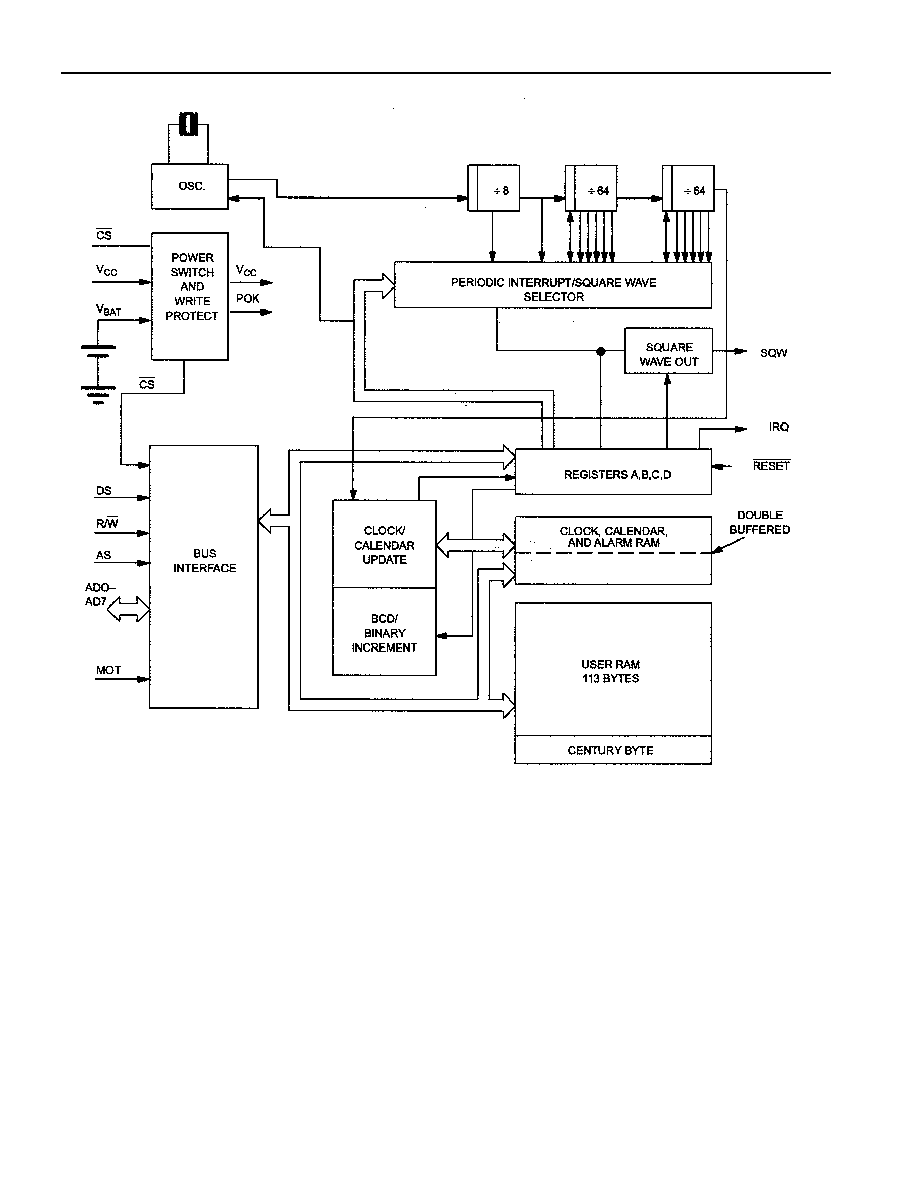 | –≠–ª–µ–∫—Ç—Ä–æ–Ω–Ω—ã–π –∫–æ–º–ø–æ–Ω–µ–Ω—Ç: 12C887 | –°–∫–∞—á–∞—Ç—å:  PDF PDF  ZIP ZIP |

1 of 19
020900
FEATURES
Drop-in replacement for IBM AT computer
clock/calendar
Pin compatible with the MC146818B and
DS1287
Totally nonvolatile with over 10 years of
operation in the absence of power
Self-contained subsystem includes lithium,
quartz, and support circuitry.
Counts seconds, minutes, hours, days, day of
the week, date, month, and year with leap
year compensation valid up to 2100
Binary or BCD representation of time,
calendar, and alarm
12≠ or 24≠hour clock with AM and PM in
12≠hour mode
Daylight Savings Time option
Selectable between Motorola and Intel bus
timing
Multiplex bus for pin efficiency
Interfaced with software as 128 RAM
locations
≠ 15 bytes of clock and control registers
≠ 113 bytes of general purpose RAM
Programmable square wave output signal
Bus≠compatible interrupt signals (IRQ)
Three interrupts are separately software
maskable and testable
≠ Time≠of≠day alarm once/second to
once/day
≠ Periodic rates from 122 ms to 500 ms
≠ End of clock update cycle
Century register
PIN ASSIGNMENT
PIN DESCRIPTION
AD0-AD7 - Multiplexed Address/Data Bus
NC
- No Connect
MOT
- Bus Type Selection
CS
- RTC Chip Select Input
AS
- Address Strobe
R/
W
- Read/Write Input
DS
- Data Strobe
RESET
- Reset Input
IRQ
- Interrupt Request Output
SQW
- Square Wave Output
V
CC
- +5 Volt Main Supply
GND
- Ground
DESCRIPTION
The DS12C887 Real Time Clock plus RAM is designed as a direct upgrade replacement for the DS12887
in existing IBM compatible personal computers to add hardware year 2000 compliance. A century byte
was added to memory location 50, 32h, as called out by the PC AT specification. A lithium energy
source, quartz crystal, and write-protection circuitry are contained within a 24≠pin dual in-line package.
As such, the DS12C887 is a complete subsystem replacing 16 components in a typical application. The
functions include a nonvolatile time-of-day clock, an alarm, a one-hundred-year calendar, programmable
interrupt, square wave generator, and 113 bytes of nonvolatile static RAM. The real time clock is
distinctive in that time-of-day and memory are maintained even in the absence of power.
DS12C887
Real Time Clock
www.dalsemi.com
MOT
1
2
3
4
5
6
7
8
9
10
11
12
23
DS12C887 24-Pin
ENCAPSULATED PACKAGE
NC
AD1
AD3
AD4
AD5
AD6
AD7
GND
V
CC
SQW
NC
NC
NC
IRQ
RESET
DS
NC
R/W
AS
CS
24
22
21
20
19
18
17
16
15
14
13
NC
AD0
AD2

DS12C887
2 of 19
OPERATION
The block diagram in Figure 1 shows the pin connections with the major internal functions of the
DS12C887. The following paragraphs describe the function of each pin.
SIGNAL DESCRIPTIONS
GND, V
CC
-
DC power is provided to the device on these pins. V
CC
is the +5 volt input. When 5 volts are
applied within normal limits, the device is fully accessible and data can be written and read. When V
CC
is
below 4.25 volts typical, reads and writes are inhibited. However, the timekeeping function continues
unaffected by the lower input voltage. As V
CC
falls below 3 volts typical, the RAM and timekeeper are
switched over to an internal lithium energy source. The timekeeping function maintains an accuracy of ±1
minute per month at 25∞C regardless of the voltage input on the V
CC
pin.
MOT (Mode Select) ≠ The MOT pin offers the flexibility to choose between two bus types. When
connected to V
CC
, Motorola bus timing is selected. When connected to GND or left disconnected, Intel
bus timing is selected. The pin has an internal pull-down resistance of approximately 20K
.
SQW (Square Wave Output) ≠ The SQW pin can output a signal from one of 13 taps provided by the
15 internal divider stages of the Real Time Clock. The frequency of the SQW pin can be changed by
programming Register A as shown in Table 1. The SQW signal can be turned on and off using the SQWE
bit in Register B. The SQW signal is not available when V
CC
is less than 4.25 volts typical.
AD0-AD7 (Multiplexed Bidirectional Address/Data Bus) ≠ Multiplexed buses save pins because
address information and data information time share the same signal paths. The addresses are present
during the first portion of the bus cycle and the same pins and signal paths are used for data in the second
portion of the cycle. Address/data multiplexing does not slow the access time of the DS12C887 since the
bus change from address to data occurs during the internal RAM access time. Addresses must be valid
prior to the falling edge of AS/ALE, at which time the DS12C887 latches the address from AD0 to AD6.
Valid write data must be present and held stable during the latter portion of the DS or WR pulses. In a
read cycle the DS12C887 outputs 8 bits of data during the latter portion of the DS or RD pulses. The read
cycle is terminated and the bus returns to a high impedance state as DS transitions low in the case of
Motorola timing or as RD transitions high in the case of Intel timing.
AS (Address Strobe Input) ≠ A positive going address strobe pulse serves to demultiplex the bus. The
falling edge of AS/ALE causes the address to be latched within the DS12C887. The next rising edge that
occurs on the AS bus will clear the address regardless of whether
CS
is asserted. Access commands
should be sent in pairs.
DS (Data Strobe or Read Input) ≠ The DS/RD pin has two modes of operation depending on the level
of the MOT pin. When the MOT pin is connected to V
CC
, Motorola bus timing is selected. In this mode
DS is a positive pulse during the latter portion of the bus cycle and is called Data Strobe. During read
cycles, DS signifies the time that the DS12C887 is to drive the bidirectional bus. In write cycles the
trailing edge of DS causes the DS12C887 to latch the written data. When the MOT pin is connected to
GND, Intel bus timing is selected. In this mode the DS pin is called Read(RD). RD identifies the time
period when the DS12C887 drives the bus with read data. The RD signal is the same definition as the
Output Enable (OE) signal on a typical memory.

DS12C887
3 of 19
R/
W (Read/Write Input) ≠ The R/ W pin also has two modes of operation. When the MOT pin is
connected to V
CC
for Motorola timing, R/W is at a level which indicates whether the current cycle is a
read or write. A read cycle is indicated with a high level on R/W while DS is high. A write cycle is
indicated when R/ W is low during DS. When the MOT pin is connected to GND for Intel timing, the
R/ W signal is an active low signal called WR. In this mode the R/ W pin has the same meaning as the
Write Enable signal (WE) on generic RAMs.
CS
(Chip Select Input)
≠ The Chip Select signal must be asserted low for a bus cycle in the DS12C887
to be accessed.
CS
must be kept in the active state during DS and AS for Motorola timing and during RD
and WR for Intel timing. Bus cycles which take place without asserting
CS
will latch addresses but no
access will occur. When V
CC
is below 4.25 volts, the DS12C887 internally inhibits access cycles by
internally disabling the
CS
input. This action protects both the real time clock data and RAM data during
power outages.
IRQ
(Interrupt Request Output)
- The
IRQ
pin is an active low output of the DS12C887 that can be
used as an interrupt input to a processor. The
IRQ
output remains low as long as the status bit causing the
interrupt is present and the corresponding interrupt-enable bit is set. To clear the
IRQ
pin the processor
program normally reads the C register. The RESET pin also clears pending interrupts. When no interrupt
conditions are present, the
IRQ
level is in the high impedance state. Multiple interrupting devices can be
connected to an
IRQ
bus. The IRQ bus is an open drain output and requires an external pull-up resistor.
RESET
(Reset Input)
≠ The RESET pin has no effect on the clock, calendar, or RAM. On power-up the
RESET pin can be held low for a time in order to allow the power supply to stabilize. The amount of
time that RESET is held low is dependent on the application. However, if RESET is used on power≠up,
the time RESET is low should exceed 200 ms to make sure that the internal timer that controls the
DS12C887 on power-up has timed out. When RESET is low and V
CC
is above 4.25 volts, the following
occurs:
A. Periodic Interrupt Enable (PEI) bit is cleared to zero.
B. Alarm Interrupt Enable (AIE) bit is cleared to zero.
C. Update Ended Interrupt Flag (UF) bit is cleared to zero.
D. Interrupt Request Status Flag (IRQF) bit is cleared to zero.
E. Periodic Interrupt Flag (PF) bit is cleared to zero.
F. The device is not accessible until RESET is returned high.
G. Alarm Interrupt Flag (AF) bit is cleared to zero.
H.
IRQ
pin is in the high impedance state.
I. Square Wave Output Enable (SQWE) bit is cleared to zero.
J. Update Ended Interrupt Enable (UIE) is cleared to zero.
In a typical application RESET can be connected to V
CC
. This connection will allow the DS12C887 to
go in and out of power fail without affecting any of the control registers.

DS12C887
4 of 19
DS12C887 BLOCK DIAGRAM Figure 1

DS12C887
5 of 19
POWER-DOWN/POWER-UP CONSIDERATIONS
The Real Time Clock function will continue to operate and all of the RAM, time, calendar, and alarm
memory locations remain nonvolatile regardless of the level of the V
CC
input. When V
CC
is applied to the
DS12C887 and reaches a level of greater than 4.25 volts, the device becomes accessible after 200 ms,
provided that the oscillator is running and the oscillator countdown chain is not in reset (see Register A).
This time period allows the system to stabilize after power is applied. When V
CC
falls below 4.25 volts,
the chip select input is internally forced to an inactive level regardless of the value of
CS
at the input pin.
The DS12C887 is, therefore, write-protected. When the DS12C887 is in a write-protected state, all inputs
are ignored and all outputs are in a high impedance state. When V
CC
falls below a level of approximately
3 volts, the external V
CC
supply is switched off and an internal lithium energy source supplies power to
the Real Time Clock and the RAM memory.
RTC ADDRESS MAP
The address map for the DS12C885 is shown in Figure 2. The address map consists of 113 bytes of user
RAM, 11 bytes of RAM that contain the RTC time, calendar, and alarm data, and 4 bytes which are used
for control and status. All 128 bytes can be directly written or read except for the following:
1.
Registers C and D are read-only.
2.
Bit-7 of Register A is read-only.
3.
The high order bit of the seconds byte is read-only.
DS12C887 REAL TIME CLOCK ADDRESS MAP Figure 2




